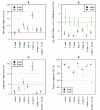Treatment of the X chromosome in mapping multiple quantitative trait loci
- PMID: 33604671
- PMCID: PMC8022961
- DOI: 10.1093/g3journal/jkab005
Treatment of the X chromosome in mapping multiple quantitative trait loci
Abstract
Statistical methods to map quantitative trait loci (QTL) often neglect the X chromosome and may focus exclusively on autosomal loci. But the X chromosome often requires special treatment: sex and cross-direction covariates may need to be included to avoid spurious evidence of linkage, and the X chromosome may require a separate significance threshold. In multiple-QTL analyses, including the consideration of epistatic interactions, the X chromosome also requires special care and consideration. We extend a penalized likelihood method for multiple-QTL model selection, to appropriately handle the X chromosome. We examine its performance in simulation and by application to a large eQTL data set. The method has been implemented in the package R/qtl.
Keywords: QTL; X chromosome; model selection.
© The Author(s) 2021. Published by Oxford University Press on behalf of Genetics Society of America.
Figures


Similar articles
-
The X chromosome in quantitative trait locus mapping.Genetics. 2006 Dec;174(4):2151-8. doi: 10.1534/genetics.106.061176. Epub 2006 Oct 8. Genetics. 2006. PMID: 17028340 Free PMC article.
-
Mapping epistatic quantitative trait loci.BMC Genet. 2014 Nov 4;15:112. doi: 10.1186/s12863-014-0112-9. BMC Genet. 2014. PMID: 25367219 Free PMC article.
-
Fine mapping of multiple interacting quantitative trait loci using combined linkage disequilibrium and linkage information.J Zhejiang Univ Sci B. 2007 Nov;8(11):787-91. doi: 10.1631/jzus.2007.B0787. J Zhejiang Univ Sci B. 2007. PMID: 17973339 Free PMC article.
-
A penalized likelihood method for mapping epistatic quantitative trait Loci with one-dimensional genome searches.Genetics. 2002 Oct;162(2):951-60. doi: 10.1093/genetics/162.2.951. Genetics. 2002. PMID: 12399402 Free PMC article.
-
QTL mapping and the genetic basis of adaptation: recent developments.Genetica. 2005 Feb;123(1-2):25-37. doi: 10.1007/s10709-004-2705-0. Genetica. 2005. PMID: 15881678 Review.
References
-
- Broman KW, Sen Ś.. 2009. A Guide to QTL Mapping with R/qtl. New York, NY: Springer. ISBN 978-0-387-92124-2.
-
- Broman KW, Wu H, Sen Ś, Churchill GA.. 2003. R/qtl: QTL mapping in experimental crosses. Bioinformatics. 19:889–890. - PubMed
Publication types
MeSH terms
Grants and funding
LinkOut - more resources
Full Text Sources
Other Literature Sources
